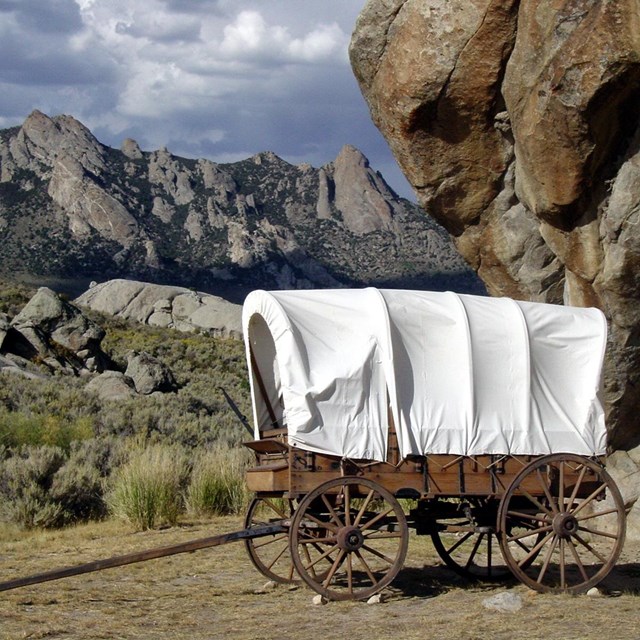Last updated: April 18, 2022
Article
Chapter 2: The Jumping-Off Places - Cosmopolitan Crossroads
Sweet Freedom's Plains
African Americans on the Overland Trails 1841-1869
By Shirley Ann Wilson Moore, PhD.
For the National Park Service
National Trails Regions 6, 7, & 8
Chapter 2 Sections
By the time of the great overland emigrations, the jumping-off places had longestablished reputations as racially, culturally, and ethnically diverse communities. Men involved in the Upper Missouri and Rocky Mountain fur trade outfitted for their journeys or even established homes or headquarters in some of these towns—for example, Joseph Robidoux at Council Bluffs and St. Joseph; and Independence was a bustling outfitting town for trade on the Santa Fe Trail. These activities attracted an international assortment of hunters, trappers, roustabouts, missionaries, laundresses, cooks, traders, tourists and other adventurers, many of whom were African American. Over time, this “heterogeneous mix resulted in a separate society of mixed-bloods: children of men of all nationalities and races and their Indian wives.”112 Their offspring, many of whom were of African descent, became important “bilingual, multicultural buffers in the merger of Indian with non-Indian society.”113
The jumping-off towns were cosmopolitan commercial arenas where buyers and sellers conducted their businesses in an international and multicultural setting. Manuel Harmony, a native of Spain who became a partner in the New York City shipping and commission firm of P. Harmony Nephews and Company, engaged in transporting English goods to Independence for freighting via the Santa Fe Trail. Doña Gertrudis “La Tules” Barceló, the shrewd New Mexican businesswoman, famed monte dealer, and gambling impresario, invested $10,000 in the Santa Fe trade in the boom year of 1843. Charles Ilfeld, a German Jewish immigrant to New Mexico, was one of a number of prominent Jewish merchants who operated mercantile stores and engaged in the Santa Fe trade. Similarly, Wyandotte Indian Chief William Walker leased a warehouse in Independence and his tribe also invested in the Santa Fe trade.114
In addition to their roles as emigrant provisioning stations, the jumping-off towns also became economic, social, and racial crossroads where blacks and whites, native-born and foreign-born, business people and laborers, Indians and Mexicans, men and women, and residents and transients interacted on a routine basis. Oregon emigrant J. Quinn Thornton described Independence in 1848:
Here might be seen the African slave with his shining black face, driving his six horse team of blood-red bays, and swaying from side to side as he sat upon the saddle and listened to the incessant tinkling of the bells . . . some [wagons] driven by Spaniards, some by Americans resembling Indians, some by negroes, and others by persons of all possible crosses between these various races.115
Next Section - Chapter 2, Doing Well and Doing Good
113 Ibid., 32. For Vanepps-Taylor’s original source of the quote about bilingual culture, see Herbert T. Hoover, “The Arrival of Capitalism on the Northern Great Plains: Pierre Choteau, Jr., and Company,” in South Dakota Leaders: From Pierre Choteau, Jr. to Oscar Howe, ed. Herbert T. Hoover and Larry J. Zimmerman (Vermillion: University of South Dakota Press, 1989), 6-10.
114 For Manuel Harmony, see Mark L. Gardner and Mark Simmons, eds., The Mexican War Correspondence of Richard Smith Elliott (Norman: University of Oklahoma Press, 1997), 239, n. 42; U.S. Department of Education, “A Tale of Two Trails: The History of the Oregon Trail,” by Amy Trenkle, Teacher-To-Teacher Workshops, Online Report, National Park Service, 2005, 5. For Doña Gertrudis Barceló, see Richard W. Etulain, Western Lives: A Biographical History of the American West (Albuquerque: Center for the Southwest, University of New Mexico, 2005), 74-83; and Sophia Truneh, “The Ilfelds: A Family Story of Jewish Pioneers in New Mexico,” Southwest Jewish History 3, no. 2 (Winter 1995), http://parentseyes.arizona.edu/bloom/sjhilfeld.htm [accessed May 3, 2011]. For more about Jewish merchants in the Santa Fe trade, also see William Patrick O’Brien, “Olam Katan” (Small World): Jewish Traders on the Santa Fe Trail,” Journal of the Southwest, 48, no. 2 (Summer 2006): 211-231.
115 J. Quinn Thornton, Oregon and California in 1848, quoted in Elizabeth McLagan, A Peculiar Paradise: A History of Blacks in Oregon, 1788-1940 (Portland: The Georgian Press, The Oregon Black History Project, 1980),




